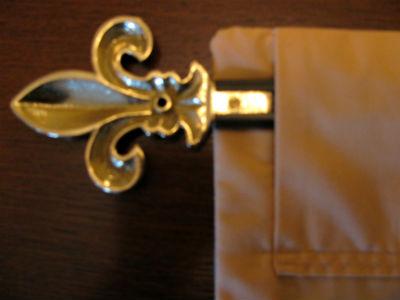Caring for Your Tapestry
As with any natural material wall tapestries can crease, particularly after being in transit during shipping or perhaps when moving home or after a period in storage. It is recommended that these creases be removed using a steam iron and muslin cloth by lightly pressing the underside of the tapestry. Do not use a damp cloth since this will stretch the yarns. It is important to test a small section of the tapestry for the correct heat settings before you begin (err on the side of caution re: heat - most tapestries have a high cotton content with some viscose and sometimes wool).
Caring for your tapestry is almost non-existent; once hung, a tapestry wallhanging will need little maintenance. It is sufficient to dust it occasionally using a soft brush or vacuum upholstery attachment. Wall tapestries can be dry cleaned but only as a last resort by professionals with a specialty in this type of product. Generally, we recommend no cleaning is done: marks on a tapestry are rare since it is hanging on a wall but if so they just add to the history of that individual piece.
Hanging a Tapestry
Hanging a tapestry is easy (really!). First, do note that since tapestries are woven individually there may be irregularities in the weave or they may have hanging undulations. They will not be precisely square and flat like a framed print.
They are finished with a rod pocket/sleeve/tunnel intended for wall decor rods since this is the most common way to hang a tapestry in your home. Rod pockets vary in depth but are sufficient for any rod you are likely to select. There are two main hanging options:
- The most economical way is to use a wooden rod. This can simply be a length of wood doweling cut to size from a hardware store or building supplier. For smaller tapestries it need only be about a finger-sized thickness, for large hangings a flat batten (as pictured below) might be better. For dowelling, the easiest way to attach it to a wall is to insert small cup-hooks into each end then place these over small protruding picture nails. This is handy since it will leave only pinprick holes if you change its position later.
- A more decorative option (shown below, on upper right) is to buy wall decor rods, having brackets and varying finials, made of wood or metal and designed to hang and display tapestry wall hangings. These can be bought from home interiors stores, hardware or drapery stores. Some rods are also expandable.
Note: Below, on the upper left is a wooden rod with closed eye hook hanging on a small nail. Simply slide the tapestry over parts you wish to obscure: this is made easy since the rod pocket is indented (as in the indented rod pocket/sleeve/tunnel in the top right photo). Also, below are other examples of hook and flat batten support for hanging your tapestry.






To help a tapestry coordinate with existing colours in a room setting you could add a pair of cords with tassels to either side of the tapestry (see examples in photos below). The colours of the cords and tassels can draw out its colours. This has the additional advantage of expanding the visual and actual size of the wall-hanging.
The ideal distance from which to view any wall art is sometimes considered to be 2.5 times the diagonal measurement of the tapestry.
With each order we supply instructions and guidelines about how to hang a tapestry and about tapestries care. We suggest you order a rod from your local store after you receive the tapestry.


